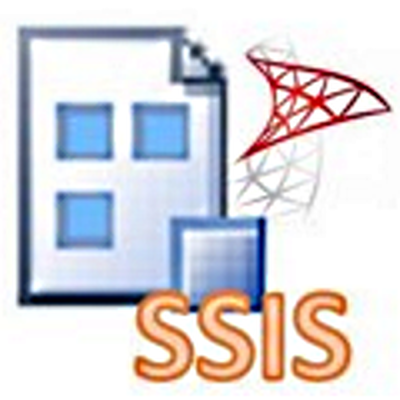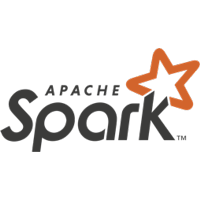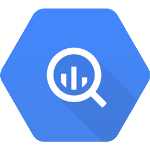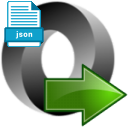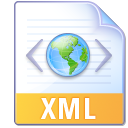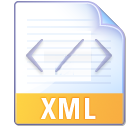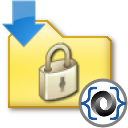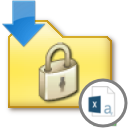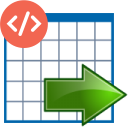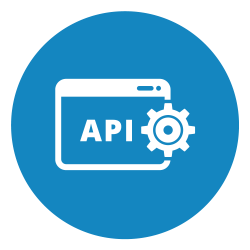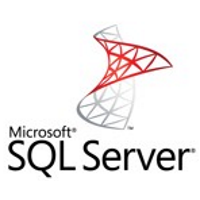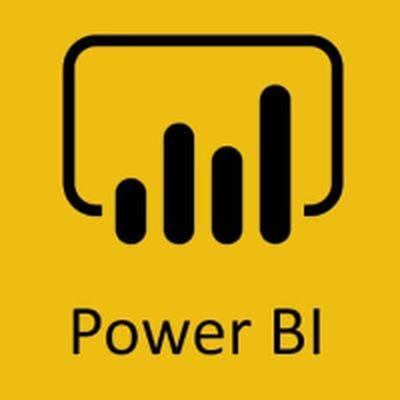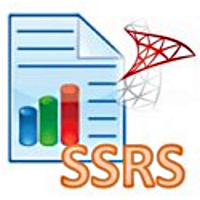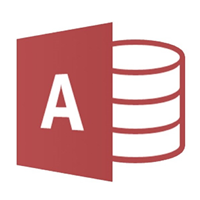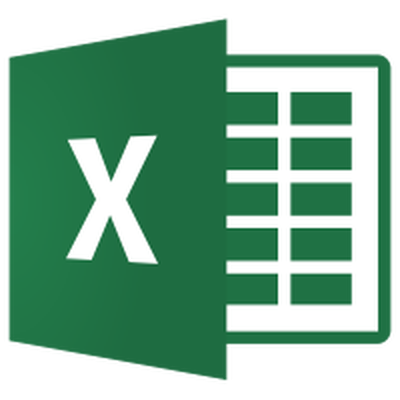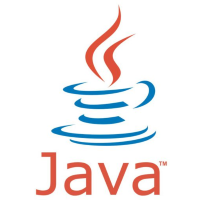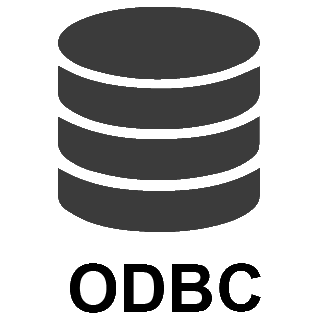Zoom Connector for SSISZoom Connector can be used to integrate Zoom REST API in your App / BI Tools. You can read/write data about Meetings, Invite, Users, Accounts and more. In this article you will learn how to quickly and efficiently integrate Zoom data in SSIS without coding. We will use high-performance Zoom Connector to easily connect to Zoom and then access the data inside SSIS. Let's follow the steps below to see how we can accomplish that! Zoom Connector for SSIS is based on ZappySys API Connector Framework which is a part of SSIS PowerPack. It is a collection of high-performance SSIS connectors that enable you to integrate data with virtually any data provider supported by SSIS, including SQL Server. SSIS PowerPack supports various file formats, sources and destinations, including REST/SOAP API, SFTP/FTP, storage services, and plain files, to mention a few (if you are new to SSIS and SSIS PowerPack, find out more on how to use them). |
Connect to Zoom in other apps
|
Video Tutorial - Integrate Zoom data in SSIS
This video covers the following topics and more, so please watch carefully. After watching the video, follow the steps outlined in this article:
- How to download and install the required PowerPack for
Zoom integration in SSIS - How to configure the connection for
Zoom - Features of the
ZappySys API Source (Authentication / Query Language / Examples / Driver UI) - How to use the
Zoom in SSIS
Prerequisites
Before we begin, make sure the following prerequisites are met:
- SSIS designer installed. Sometimes it is referred as BIDS or SSDT (download it from Microsoft).
- Basic knowledge of SSIS package development using Microsoft SQL Server Integration Services.
- SSIS PowerPack is installed (if you are new to SSIS PowerPack, then get started!).
Read data from Zoom in SSIS (Export data)
In this section we will learn how to configure and use Zoom Connector in API Source to extract data from Zoom.
-
Begin with opening Visual Studio and Create a New Project.
Select Integration Service Project and in new project window set the appropriate name and location for project. And click OK.
-
In the new SSIS project screen you will find the following:
- SSIS ToolBox on left side bar
- Solution Explorer and Property Window on right bar
- Control flow, data flow, event Handlers, Package Explorer in tab windows
- Connection Manager Window in the bottom
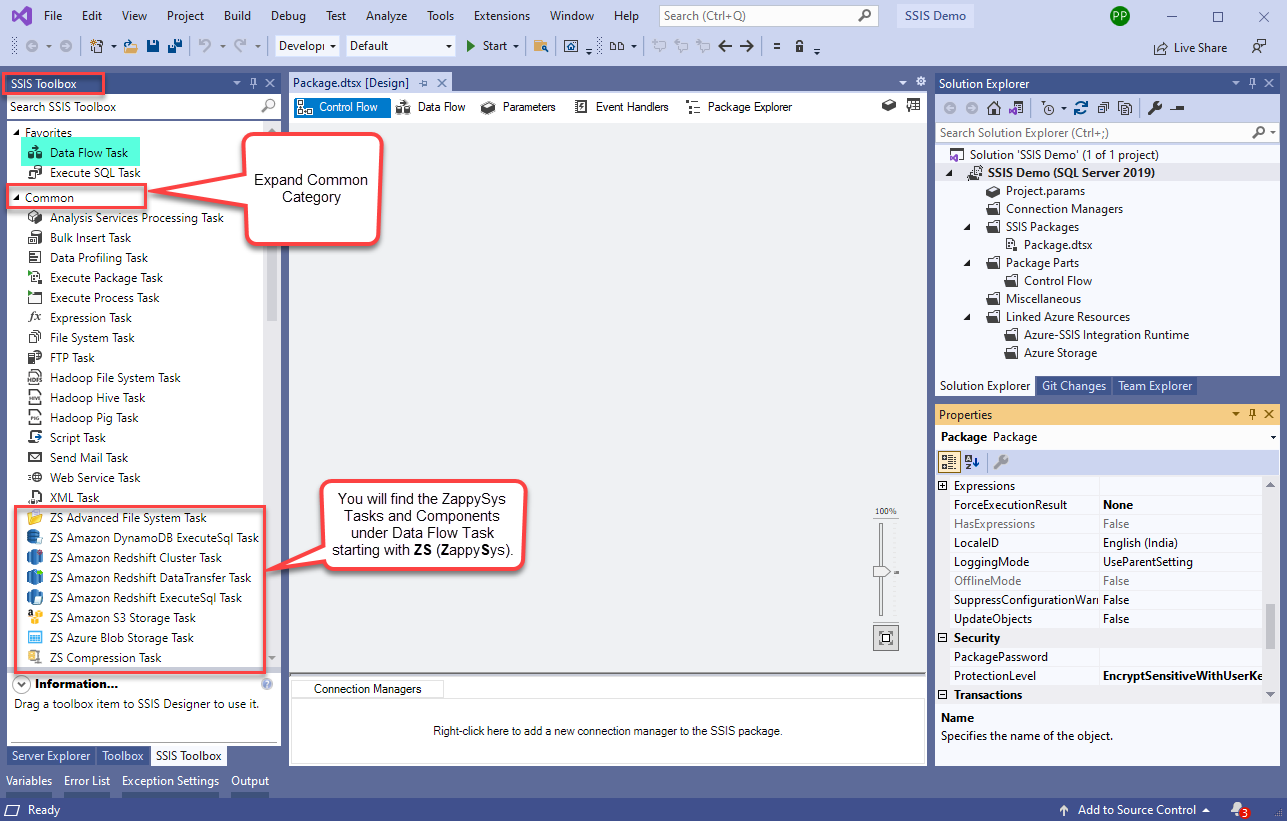 Note: If you don't see ZappySys SSIS PowerPack Task or Components in SSIS Toolbox, please refer to this help link.
Note: If you don't see ZappySys SSIS PowerPack Task or Components in SSIS Toolbox, please refer to this help link. -
Now, Drag and Drop SSIS Data Flow Task from SSIS Toolbox. Double click on the Data Flow Task to see Data Flow designer.
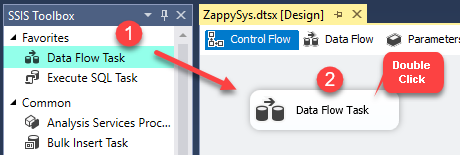
-
From the SSIS toolbox drag and API Source (Predefined Templates) on the data flow designer surface, and double click on it to edit it:
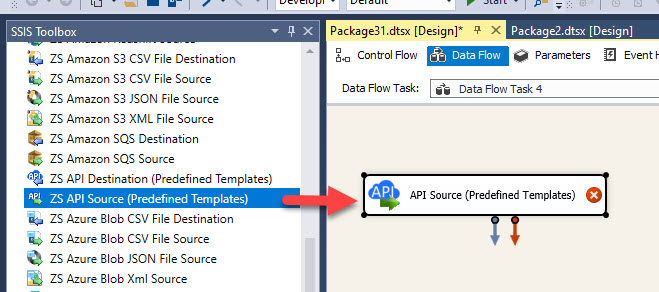
-
Select New Connection to create a new connection:
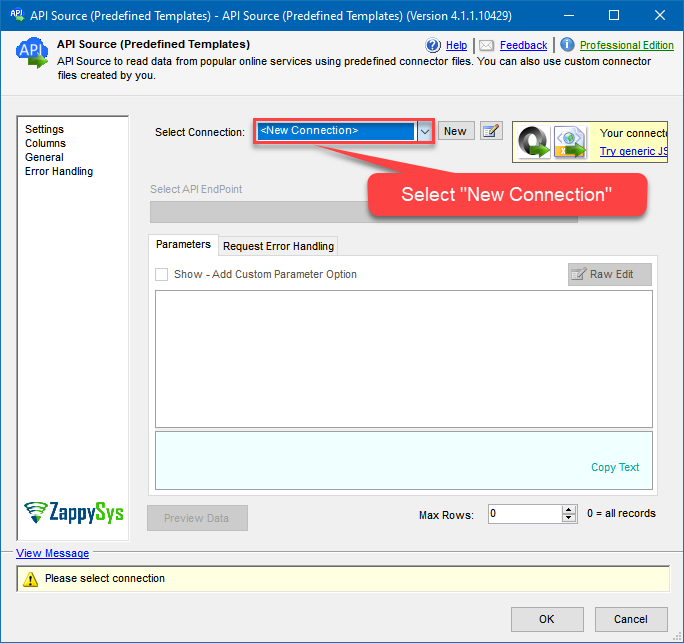
-
Use a preinstalled Zoom Connector from Popular Connector List or press Search Online radio button to download Zoom Connector. Once downloaded simply use it in the configuration:
Zoom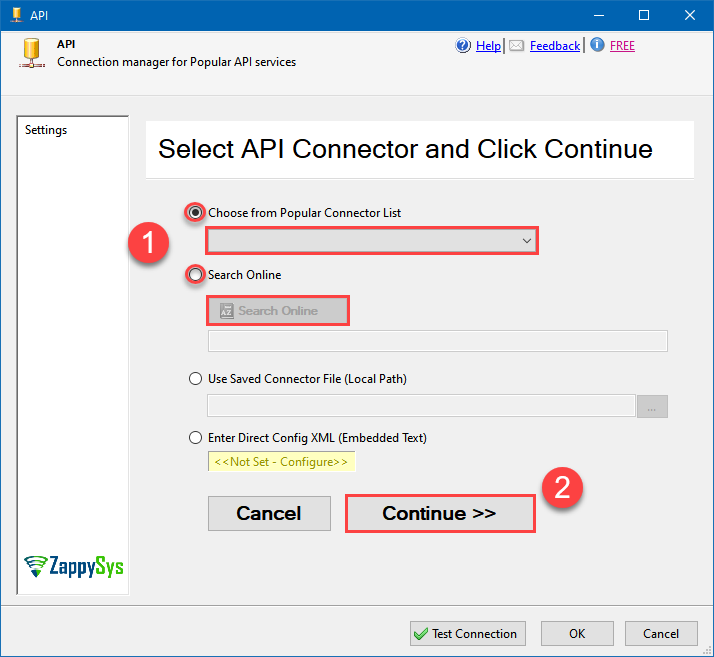
-
Proceed with selecting the desired Authentication Type. Then select API Base URL (in most cases default one is the right one). Finally, fill in all the required parameters and set optional parameters if needed. You may press a link Steps to Configure which will help set certain parameters. More info is available in Authentication section.
OAuth App must be created under Admin Console > Channel > API > Settings. [API reference]
Steps how to get and use Zoom credentials : OAuth Authentication [OAuth]
Perform the following steps to get the Zoom OAuth credentials (i.e. Client ID and Client Secret)
- Go to Zoom Marketplace Portal and sign in there.
- Once you successfully login then select "Build App" option from Develop dropdown from top left on the page.
- Click on Create button of OAuth panel section of page.
- Enter the name for your application and choose app type (Recommneded "Account-Level App") option for your API
- Then proceed with clicking Create button.
- In Redirect URL for OAuth enter this https://zappysys.com/oauth as Redirect URI and add it to allow lists.
- Copy Client ID and Client Secret here and paste it into Connection Manager Required Paramters section in respective place holders
- Add appropiate scopes from the Scopes menu option to the right side of page for your API as below :
- meeting:read;
- meeting:write;
- user:read;
- user:write;
- user_info:read;
- meeting:read:admin;
- chat_channel:read;
- chat_channel:write;
- chat_contact:read;
- chat_message:read;
- chat_message:write;
- contact:read;
- pac:read;
- pac:write;
- phone:read;
- phone:write
- phone_call_control:read;
- phone_call_control:write;
- phone_call_log:read;
- phone_call_log:write;
- phone_e911:read;
- phone_recording:read;
- phone_recording:write;
- phone_sms:read;
- phone_sms:write;
- phone_voicemail:read;
- phone_voicemail:write;
- recording:read;
- recording:write;
- tsp:read
- tsp:write;
- user:read;
- user:write;
- user_info:read;
- user_zak:read;
- webinar:read;
- webinar:write
- Click Generate Token button on Connection Manager UI to generate tokens.
- That's it!
Configuring authentication parameters
ZoomOAuth Authentication [OAuth]https://api.zoom.us/v2Required Parameters ClientId Fill-in the parameter... ClientSecret Fill-in the parameter... RedirectUrl Fill-in the parameter... TokenUrl Fill-in the parameter... AuthorizationUrl Fill-in the parameter... Optional Parameters Scope RetryMode RetryWhenStatusCodeMatch RetryStatusCodeList 429 RetryCountMax 5 RetryMultiplyWaitTime True 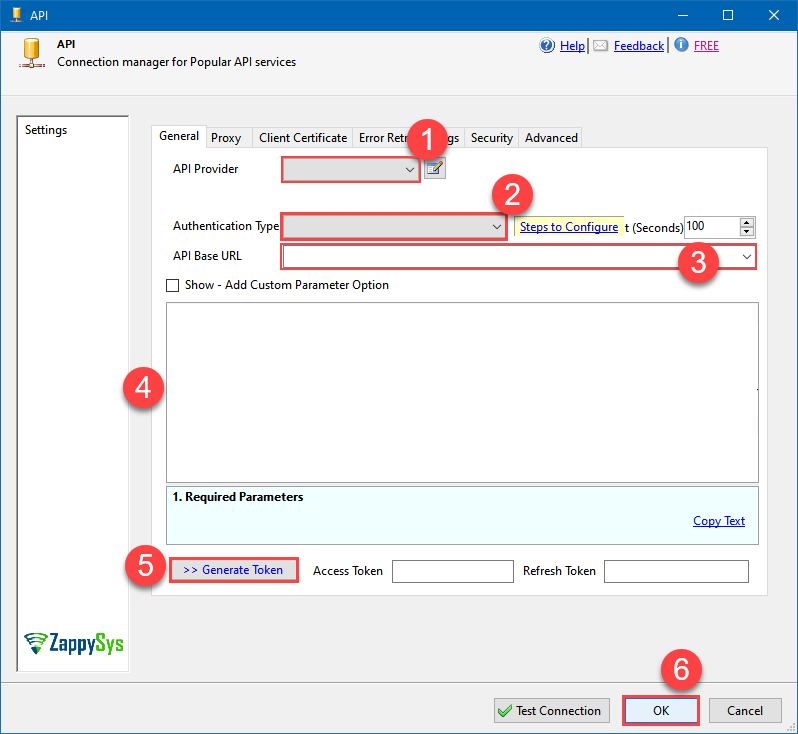
-
Select the desired endpoint, change/pass the properties values, and click on Preview Data button to make the API call.
API Source - ZoomZoom Connector can be used to integrate Zoom REST API in your App / BI Tools. You can read/write data about Meetings, Invite, Users, Accounts and more.
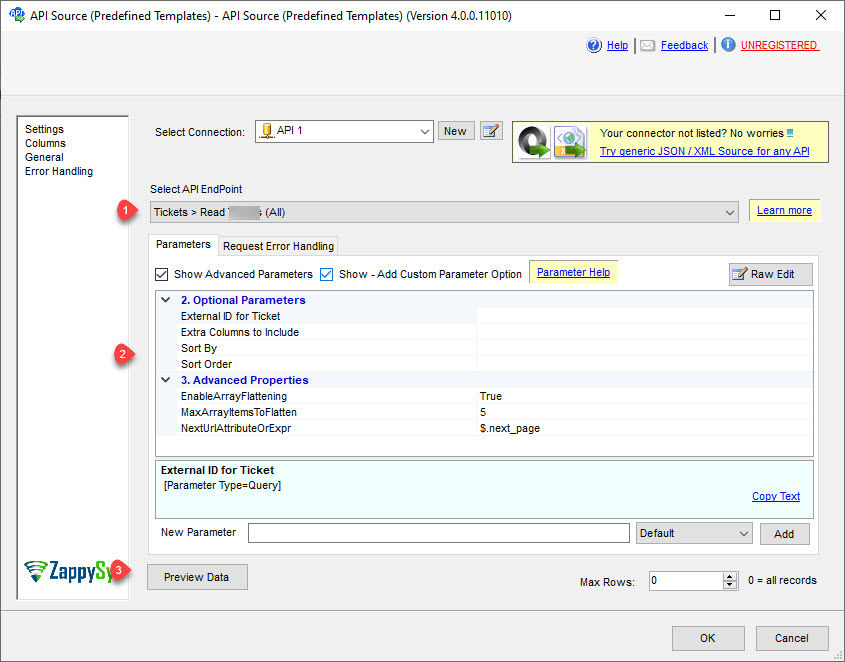
-
That's it! We are done! Just in a few clicks we configured the call to Zoom using Zoom Connector.
You can load the source data into your desired destination using the Upsert Destination, which supports SQL Server, PostgreSQL, and Amazon Redshift. We also offer other destinations such as CSV, Excel, Azure Table, Salesforce, and more. You can check out our SSIS PowerPack Tasks and components for more options. (*loaded in Trash Destination)
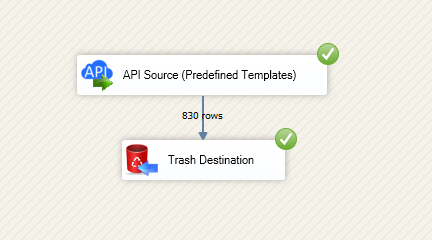
Write data to Zoom using SSIS (Import data)
In this section we will learn how to configure and use Zoom Connector in the API Destination to write data to Zoom.
Video tutorial
This video covers following and more so watch carefully. After watching this video follow the steps described in this article.
- How to download SSIS PowerPack for
Zoom integration in SSIS - How to configure connection for
Zoom - How to write or lookup data to
Zoom - Features about SSIS API Destination
- Using
Zoom Connector in SSIS
Step-by-step instructions
In upper section we learned how to read data, now in this section we will learn how to configure Zoom in the API Source to POST data to the Zoom.
-
Read the data from the source, being any desired source component. In example we will use ZappySys Dummy Data Source component.
-
From the SSIS Toolbox drag and drop API Destination (Predefined Templates) on the Data Flow Designer surface and connect source component with it, and double click to edit it.
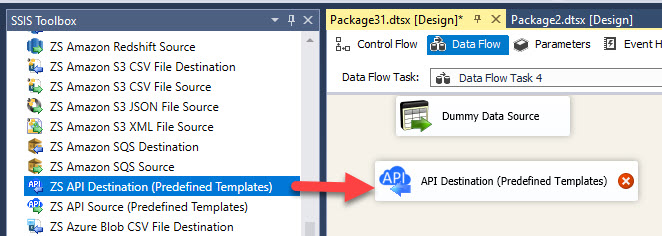
-
Select New Connection to create a new connection:
API Destination - ZoomZoom Connector can be used to integrate Zoom REST API in your App / BI Tools. You can read/write data about Meetings, Invite, Users, Accounts and more.
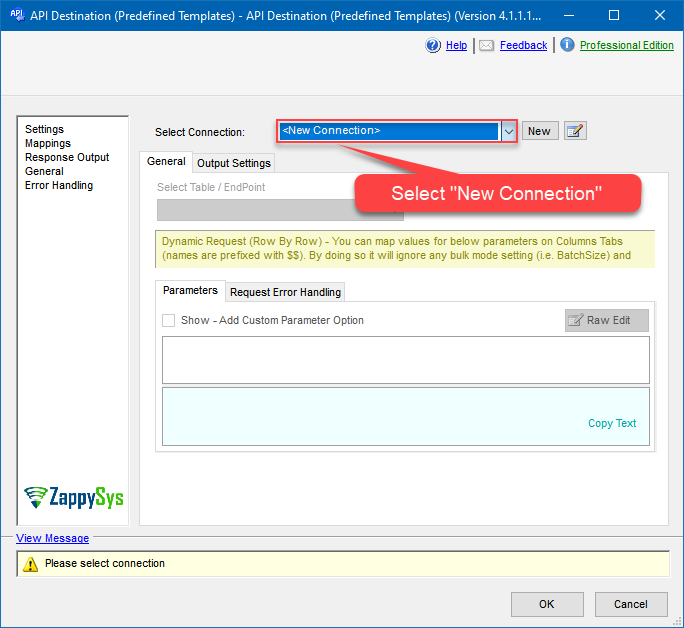
-
Use a preinstalled Zoom Connector from Popular Connector List or press Search Online radio button to download Zoom Connector. Once downloaded simply use it in the configuration:
Zoom
-
Proceed with selecting the desired Authentication Type. Then select API Base URL (in most cases default one is the right one). Finally, fill in all the required parameters and set optional parameters if needed. You may press a link Steps to Configure which will help set certain parameters. More info is available in Authentication section.
OAuth App must be created under Admin Console > Channel > API > Settings. [API reference]
Steps how to get and use Zoom credentials : OAuth Authentication [OAuth]
Perform the following steps to get the Zoom OAuth credentials (i.e. Client ID and Client Secret)
- Go to Zoom Marketplace Portal and sign in there.
- Once you successfully login then select "Build App" option from Develop dropdown from top left on the page.
- Click on Create button of OAuth panel section of page.
- Enter the name for your application and choose app type (Recommneded "Account-Level App") option for your API
- Then proceed with clicking Create button.
- In Redirect URL for OAuth enter this https://zappysys.com/oauth as Redirect URI and add it to allow lists.
- Copy Client ID and Client Secret here and paste it into Connection Manager Required Paramters section in respective place holders
- Add appropiate scopes from the Scopes menu option to the right side of page for your API as below :
- meeting:read;
- meeting:write;
- user:read;
- user:write;
- user_info:read;
- meeting:read:admin;
- chat_channel:read;
- chat_channel:write;
- chat_contact:read;
- chat_message:read;
- chat_message:write;
- contact:read;
- pac:read;
- pac:write;
- phone:read;
- phone:write
- phone_call_control:read;
- phone_call_control:write;
- phone_call_log:read;
- phone_call_log:write;
- phone_e911:read;
- phone_recording:read;
- phone_recording:write;
- phone_sms:read;
- phone_sms:write;
- phone_voicemail:read;
- phone_voicemail:write;
- recording:read;
- recording:write;
- tsp:read
- tsp:write;
- user:read;
- user:write;
- user_info:read;
- user_zak:read;
- webinar:read;
- webinar:write
- Click Generate Token button on Connection Manager UI to generate tokens.
- That's it!
Configuring authentication parameters
ZoomOAuth Authentication [OAuth]https://api.zoom.us/v2Required Parameters ClientId Fill-in the parameter... ClientSecret Fill-in the parameter... RedirectUrl Fill-in the parameter... TokenUrl Fill-in the parameter... AuthorizationUrl Fill-in the parameter... Optional Parameters Scope RetryMode RetryWhenStatusCodeMatch RetryStatusCodeList 429 RetryCountMax 5 RetryMultiplyWaitTime True 
-
Select the desired endpoint, change/pass the properties values, and go to the Mappings tab to map the columns.
API Destination - ZoomZoom Connector can be used to integrate Zoom REST API in your App / BI Tools. You can read/write data about Meetings, Invite, Users, Accounts and more.
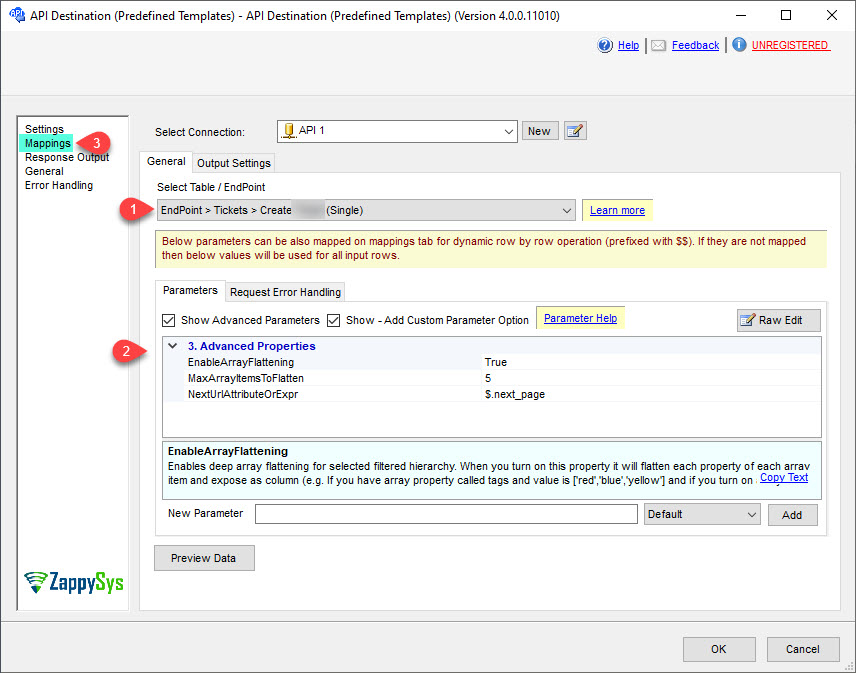
-
Finally, map the desired columns:
API Destination - ZoomZoom Connector can be used to integrate Zoom REST API in your App / BI Tools. You can read/write data about Meetings, Invite, Users, Accounts and more.
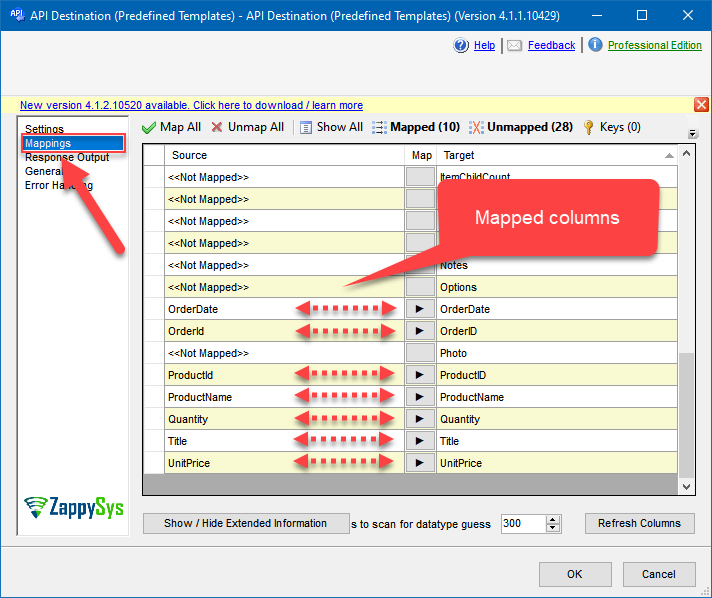
-
That's it; we successfully configured the POST API Call. In a few clicks we configured the Zoom API call using ZappySys Zoom Connector
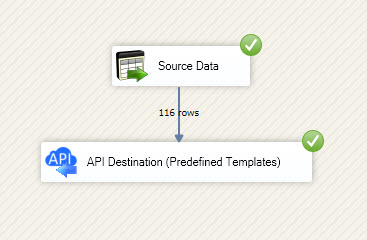
Load Zoom data into SQL Server using Upsert Destination (Insert or Update)
Once you configured the data source, you can load Zoom data into SQL Server using Upsert Destination.
Upsert Destination can merge or synchronize source data with the target table.
It supports Microsoft SQL Server, PostgreSQL, and Redshift databases as targets.
Upsert Destination also supports very fast bulk upsert operation along with bulk delete.
Upsert operation
- a database operation which performs INSERT or UPDATE SQL commands
based on record's existence condition in the target table.
It
Upsert Destination supports INSERT, UPDATE, and DELETE operations,
so it is similar to SQL Server's MERGE command, except it can be used directly in SSIS package.
-
From the SSIS Toolbox drag-and-drop Upsert Destination component onto the Data Flow designer background.
-
Connect your SSIS source component to Upsert Destination.
-
Double-click on Upsert Destination component to open configuration window.
-
Start by selecting the Action from the list.
-
Next, select the desired target connection or create one by clicking <New [provider] Connection> menu item from the Target Connection dropdown.
-
Then select a table from the Target Table list or click New button to create a new table based on the source columns.
-
Continue by checking Insert and Update options according to your scenario (e.g. if Update option is unchecked, no updates will be made).
-
Finally, click Map All button to map all columns and then select the Key columns to match the columns on:
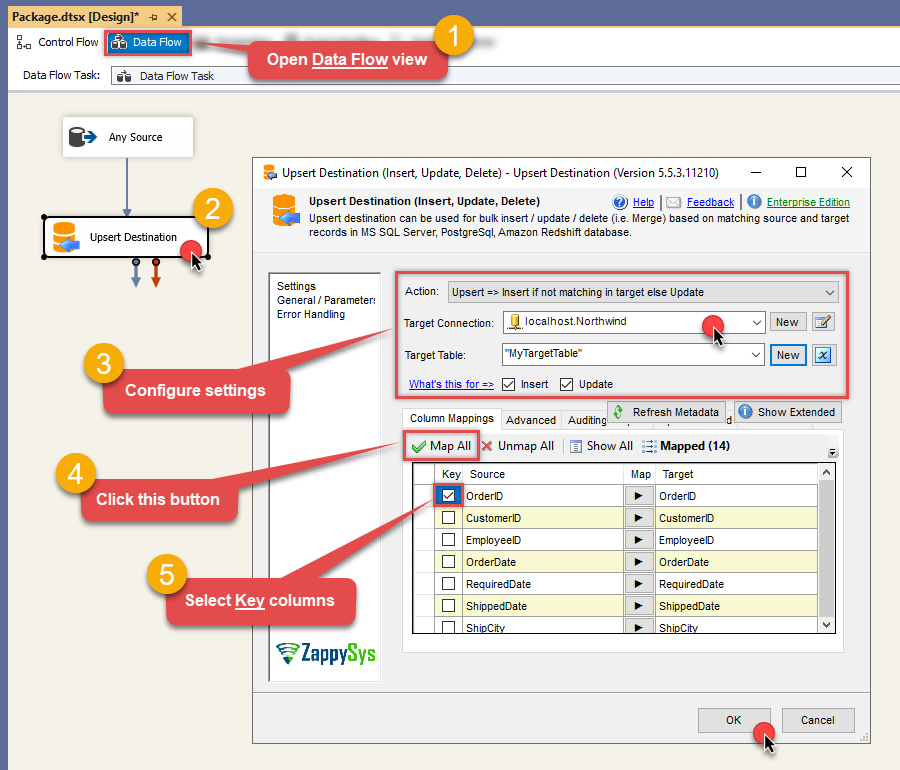
-
Click OK to save the configuration.
-
Run the package and Zoom data will be merged with the target table in SQL Server, PostgreSQL, or Redshift:
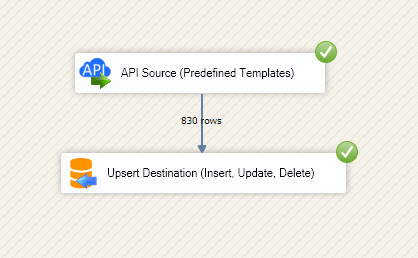
-
Done!
Deploy and schedule SSIS package
After you are done creating SSIS package, most likely, you want to deploy it to SQL Server Catalog and run it periodically. Just follow the instructions in this article:
Running SSIS package in Azure Data Factory (ADF)
To use SSIS PowerPack in ADF, you must first prepare Azure-SSIS Integration Runtime. Follow this link for detailed instructions:
Actions supported by Zoom Connector
Zoom Connector supports following actions for REST API integration:
Get Meeting By Id
Description
The Meeting Id or email address of the user. For user-level apps, pass the me value.
Parameters
You can provide the following parameters to this action:
-
MeetingId
Input Fields
You can provide the following fields to this action:
-
N/A
Output Fields
The following fields are returned after calling this action:
-
id -
host_id -
host_email -
assistant_id -
topic -
type -
status -
timezone -
agenda -
created_at -
start_url -
join_url -
registration_url -
password -
h323_password -
pstn_password -
encrypted_password -
occurrences -
settings_host_video -
settings_participant_video -
settings_cn_meeting -
settings_in_meeting -
settings_join_before_host -
settings_jbh_time -
settings_mute_upon_entry -
settings_watermark -
settings_use_pmi -
settings_approval_type -
settings_registration_type -
settings_audio -
settings_auto_recording -
settings_enforce_login -
settings_enforce_login_domains -
settings_alternative_hosts -
settings_alternative_host_update_polls -
settings_close_registration -
settings_show_share_button -
settings_allow_multiple_devices -
settings_registrants_confirmation_email -
settings_waiting_room -
settings_request_permission_to_unmute_participants -
settings_global_dial_in_countries -
settings_global_dial_in_numbers -
settings_registrants_email_notification -
settings_meeting_authentication -
settings_encryption_type -
settings_approved_or_denied_countries_or_regions_enable -
settings_breakout_room_enable -
settings_alternative_hosts_email_notification -
settings_device_testing -
settings_focus_mode -
settings_private_meeting -
settings_email_notification -
recurrence_type -
recurrence_repeat_interval -
recurrence_end_date_time -
pre_schedule -
uuid
Visit documentation for more information.
GET Settings
Description
Retrieve a user's settings. For user-level apps, pass the me value instead of the userId parameter.
Parameters
You can provide the following parameters to this action:
-
UserId
Input Fields
You can provide the following fields to this action:
-
N/A
Output Fields
The following fields are returned after calling this action:
-
schedule_meeting_host_video -
schedule_meeting_participants_video -
schedule_meeting_audio_type -
schedule_meeting_join_before_host -
schedule_meeting_personal_meeting -
schedule_meeting_use_pmi_for_scheduled_meetings -
schedule_meeting_use_pmi_for_instant_meetings -
schedule_meeting_force_pmi_jbh_password -
schedule_meeting_require_password_for_scheduling_new_meetings -
schedule_meeting_require_password_for_scheduled_meetings -
schedule_meeting_default_password_for_scheduled_meetings -
schedule_meeting_require_password_for_instant_meetings -
schedule_meeting_require_password_for_pmi_meetings -
schedule_meeting_pmi_password -
schedule_meeting_pstn_password_protected -
schedule_meeting_mute_upon_entry -
schedule_meeting_embed_password_in_join_link -
schedule_meeting_meeting_password_requirement_length -
schedule_meeting_meeting_password_requirement_have_letter -
schedule_meeting_meeting_password_requirement_have_number -
schedule_meeting_meeting_password_requirement_have_special_character -
schedule_meeting_meeting_password_requirement_have_upper_and_lower_characters -
schedule_meeting_meeting_password_requirement_only_allow_numeric -
schedule_meeting_meeting_password_requirement_consecutive_characters_length -
schedule_meeting_meeting_password_requirement_weak_enhance_detection -
in_meeting_e2e_encryption -
in_meeting_chat -
in_meeting_private_chat -
in_meeting_auto_saving_chat -
in_meeting_entry_exit_chime -
in_meeting_record_play_voice -
in_meeting_file_transfer -
in_meeting_feedback -
in_meeting_attendee_on_hold -
in_meeting_show_meeting_control_toolbar -
in_meeting_allow_show_zoom_windows -
in_meeting_annotation -
in_meeting_remote_control -
in_meeting_non_verbal_feedback -
in_meeting_breakout_room -
in_meeting_closed_caption -
in_meeting_remote_support -
in_meeting_far_end_camera_control -
in_meeting_virtual_background -
in_meeting_virtual_background_settings_enable -
in_meeting_virtual_background_settings_allow_videos -
in_meeting_virtual_background_settings_allow_upload_custom -
in_meeting_virtual_background_settings_files -
in_meeting_auto_answer -
in_meeting_screen_sharing -
in_meeting_attention_mode_focus_mode -
in_meeting_who_can_share_screen -
in_meeting_who_can_share_screen_when_someone_is_sharing -
in_meeting_waiting_room -
in_meeting_participants_to_place_in_waiting_room -
in_meeting_request_permission_to_unmute_participants -
in_meeting_meeting_reactions -
in_meeting_show_a_join_from_your_browser_link -
in_meeting_allow_participants_to_rename -
in_meeting_allow_participants_chat_with -
in_meeting_allow_users_save_chats -
in_meeting_meeting_polling_enable -
in_meeting_closed_captioning_enable -
in_meeting_closed_captioning_save_caption -
in_meeting_slide_control -
in_meeting_webinar_polling_enable -
in_meeting_disable_screen_sharing_for_host_meetings -
in_meeting_disable_screen_sharing_for_in_meeting_guests -
email_notification_jbh_reminder -
email_notification_cancel_meeting_reminder -
recording_local_recording -
recording_auto_recording -
recording_recording_disclaimer -
recording_auto_delete_cmr -
recording_recording_password_requirement_length -
recording_recording_password_requirement_have_letter -
recording_recording_password_requirement_have_number -
recording_recording_password_requirement_have_special_character -
recording_recording_password_requirement_only_allow_numeric -
telephony_third_party_audio -
telephony_audio_conference_info -
telephony_show_international_numbers_link -
telephony_telephony_regions_allowed_values -
feature_meeting_capacity -
feature_large_meeting -
feature_webinar -
feature_zoom_events -
feature_cn_meeting -
feature_in_meeting -
feature_zoom_phone -
feature_zoom_iq_for_sales -
integration_linkedin_sales_navigator -
audio_conferencing_toll_free_and_fee_based_toll_call_enable
Visit documentation for more information.
Get Webinar Settings
Description
Use this API to get settings details of a scheduled webinar.
Parameters
You can provide the following parameters to this action:
-
WebinarId
Input Fields
You can provide the following fields to this action:
-
N/A
Output Fields
The following fields are returned after calling this action:
-
host_video -
panelists_video -
approval_type -
audio -
auto_recording -
enforce_login -
enforce_login_domains -
alternative_hosts -
alternative_host_update_polls -
close_registration -
show_share_button -
allow_multiple_devices -
practice_session -
hd_video -
question_answer -
registrants_confirmation_email -
on_demand -
request_permission_to_unmute_participants -
contact_name -
contact_email -
registrants_restrict_number -
registrants_email_notification -
post_webinar_survey -
meeting_authentication -
question_and_answer_enable -
question_and_answer_allow_anonymous_questions -
question_and_answer_answer_questions -
question_and_answer_attendees_can_upvote -
question_and_answer_attendees_can_comment -
hd_video_for_attendees -
send_1080p_video_to_attendees -
email_language -
panelists_invitation_email_notification -
attendees_and_panelists_reminder_email_notification_enable -
attendees_and_panelists_reminder_email_notification_type -
follow_up_attendees_email_notification_enable -
follow_up_attendees_email_notification_type -
follow_up_absentees_email_notification_enable -
follow_up_absentees_email_notification_type -
enable_session_branding
Visit documentation for more information.
Get Webinar Settings By Id
Description
Use this API to get details of a scheduled webinar.
Parameters
You can provide the following parameters to this action:
-
WebinarId
Input Fields
You can provide the following fields to this action:
-
N/A
Output Fields
The following fields are returned after calling this action:
-
id -
host_id -
host_email -
topic -
type -
start_time -
duration -
timezone -
agenda -
created_at -
start_url -
join_url -
password -
settings_host_video -
settings_panelists_video -
settings_approval_type -
settings_audio -
settings_auto_recording -
settings_enforce_login -
settings_enforce_login_domains -
settings_alternative_hosts -
settings_alternative_host_update_polls -
settings_close_registration -
settings_show_share_button -
settings_allow_multiple_devices -
settings_practice_session -
settings_hd_video -
settings_question_answer -
settings_registrants_confirmation_email -
settings_on_demand -
settings_request_permission_to_unmute_participants -
settings_contact_name -
settings_contact_email -
settings_registrants_restrict_number -
settings_registrants_email_notification -
settings_post_webinar_survey -
settings_meeting_authentication -
settings_question_and_answer_enable -
settings_question_and_answer_allow_anonymous_questions -
settings_question_and_answer_answer_questions -
settings_question_and_answer_attendees_can_upvote -
settings_question_and_answer_attendees_can_comment -
settings_hd_video_for_attendees -
settings_send_1080p_video_to_attendees -
settings_email_language -
settings_panelists_invitation_email_notification -
settings_attendees_and_panelists_reminder_email_notification_enable -
settings_attendees_and_panelists_reminder_email_notification_type -
settings_follow_up_attendees_email_notification_enable -
settings_follow_up_attendees_email_notification_type -
settings_follow_up_absentees_email_notification_enable -
settings_follow_up_absentees_email_notification_type -
settings_enable_session_branding -
uuid
Visit documentation for more information.
List Meeting Registrants
Description
A host or a user with admin permission can require registration for a Zoom meeting. Use this API to list users that have registered for a meeting.
Parameters
You can provide the following parameters to this action:
-
UserId -
MeetingId -
PageSize
Input Fields
You can provide the following fields to this action:
-
N/A
Output Fields
The following fields are returned after calling this action:
-
id -
first_name -
last_name -
email -
address -
city -
country -
zip -
state -
phone -
industry -
org -
job_title -
purchasing_time_frame -
role_in_purchase_process -
no_of_employees -
comments -
custom_questions -
status -
create_time -
join_url
Visit documentation for more information.
List Meetings
Description
Get the list of scheduled meetings. For current user (me) or specified user Id. To get more details about a meeting you can call get_meeting EndPoint.
Parameters
You can provide the following parameters to this action:
-
UserId -
PageSize
Input Fields
You can provide the following fields to this action:
-
N/A
Output Fields
The following fields are returned after calling this action:
-
id -
topic -
type -
start_time -
duration -
timezone -
agenda -
created_at -
join_url -
pmi -
uuid
Visit documentation for more information.
List Registration Questions
Description
List registration questions that will be displayed to users while registering for a meeting.
Parameters
You can provide the following parameters to this action:
-
MeetingId
Input Fields
You can provide the following fields to this action:
-
N/A
Output Fields
The following fields are returned after calling this action:
-
questions -
custom_questions
Visit documentation for more information.
List Users
Description
Use this API to list your account's users.'s users.
Parameters
You can provide the following parameters to this action:
-
PageSize
Input Fields
You can provide the following fields to this action:
-
N/A
Output Fields
The following fields are returned after calling this action:
-
id -
first_name -
last_name -
email -
type -
pmi -
timezone -
verified -
dept -
created_at -
last_login_time -
last_client_version -
pic_url -
language -
phone_number -
status -
role_id
Visit documentation for more information.
List Webinar Registrants
Description
Use this API to list all the users that have registered for a webinar.
Parameters
You can provide the following parameters to this action:
-
WebinarId -
PageSize
Input Fields
You can provide the following fields to this action:
-
N/A
Output Fields
The following fields are returned after calling this action:
-
id -
first_name -
last_name -
email -
address -
city -
country -
zip -
state -
phone -
industry -
org -
job_title -
purchasing_time_frame -
role_in_purchase_process -
no_of_employees -
comments -
custom_questions -
status -
create_time -
join_url
Visit documentation for more information.
List Webinars
Description
Use this API to list all the webinars scheduled by or on-behalf a user (webinar host). For user-level apps, pass the me value instead of the userId parameter.
Parameters
You can provide the following parameters to this action:
-
UserId -
PageSize
Input Fields
You can provide the following fields to this action:
-
N/A
Output Fields
The following fields are returned after calling this action:
-
id -
host_id -
topic -
type -
start_time -
duration -
timezone -
created_at -
join_url -
uuid
Visit documentation for more information.
Past Meeting
Description
Use this API to get information about a past meeting.
Parameters
You can provide the following parameters to this action:
-
MeetingId -
PageSize
Input Fields
You can provide the following fields to this action:
-
N/A
Output Fields
The following fields are returned after calling this action:
-
id -
host_id -
type -
topic -
user_name -
user_email -
start_time -
end_time -
duration -
total_minutes -
participants_count -
dept -
source -
uuid
Visit documentation for more information.
Make Generic API Request
Description
This is generic endpoint. Use this endpoint when some actions are not implemented by connector. Just enter partial URL (Required), Body, Method, Header etc. Most parameters are optional except URL.
Parameters
You can provide the following parameters to this action:
-
Url -
Body -
IsMultiPart -
Filter -
Headers
Input Fields
You can provide the following fields to this action:
-
N/A
Output Fields
The following fields are returned after calling this action:
-
N/A
Visit documentation for more information.
Make Generic API Request (Bulk Write)
Description
This is a generic endpoint for bulk write purpose. Use this endpoint when some actions are not implemented by connector. Just enter partial URL (Required), Body, Method, Header etc. Most parameters are optional except URL.
Parameters
You can provide the following parameters to this action:
-
Url -
IsMultiPart -
Filter -
Headers
Input Fields
You can provide the following fields to this action:
-
N/A
Output Fields
The following fields are returned after calling this action:
-
N/A
Visit documentation for more information.
Conclusion
In this article we showed you how to connect to Zoom in SSIS and integrate data without any coding, saving you time and effort.
We encourage you to download Zoom Connector for SSIS and see how easy it is to use it for yourself or your team.
If you have any questions, feel free to contact ZappySys support team. You can also open a live chat immediately by clicking on the chat icon below.
Download Zoom Connector for SSIS Documentation

